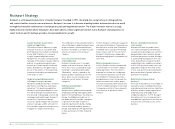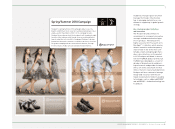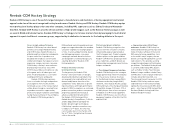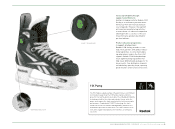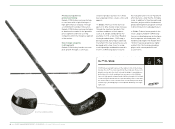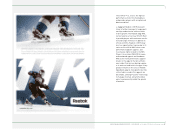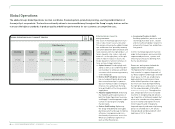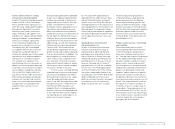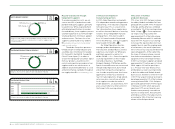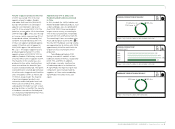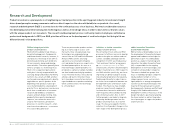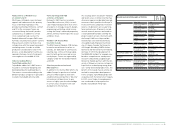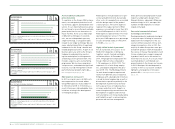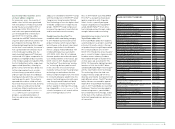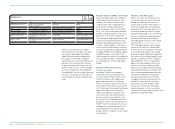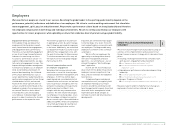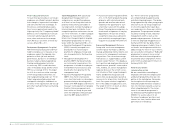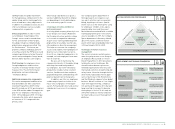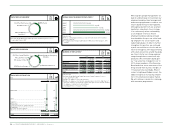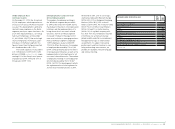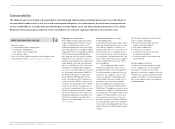Reebok 2009 Annual Report Download - page 96
Download and view the complete annual report
Please find page 96 of the 2009 Reebok annual report below. You can navigate through the pages in the report by either clicking on the pages listed below, or by using the keyword search tool below to find specific information within the annual report.
Research and Development
Product innovation is a prerequisite to strengthening our market position in the sporting goods industry. Innovational strength
drives brand perception among consumers and has a direct impact on the value attributable to our products. As a result,
research and development (R&D) is a cornerstone for the continued success of our business. We invest considerable resources
into developing and commercialising new technologies as well as fresh design ideas, in order to best unite our brands’ values
with the unique needs of our consumers. The research and development process is driven by teams of employees with diverse
professional backgrounds. In 2010, our R&D priorities will focus on the development of such technologies that bring to life our
different brands’ value propositions.
R&D an integral part of the
product creation process
R&D within the adidas Group follows a
decentralised approach. Fundamental
and biomechanical research, however, is
shared across the Group. In line with its
distinctive positioning, each brand runs
its own research, design and develop-
ment activities. The teams generally have
either a category or a technology focus.
R&D is not a separate organisational
entity, but is closely integrated with the
sourcing, design and product marketing
functions. As a result, all R&D activities
are focused on producing results directly
applicable to a specific product. At the
beginning of the product creation pro-
cess, marketing defines a development
priority. This is derived on a case-by-case
basis from a combination of consumer
research and feedback, competition
analysis and own product testing. Inde-
pendently from specific development
requests, our innovation teams also
analyse new materials, production
processes or scientific research – often
even from other industries – to increase
the scope of idea generation.
These are presented to product market-
ing at an early stage to assess com-
merciality. Once conceptualised, new
technologies are engineered using
state-of-the-art CAD and Finite Element
Analysis (FEA) systems. Sourcing
specialists are consulted to integrate
cost and production
process aspects into
the development phase. As soon as a
new technology is deemed viable, it is
produced as a
physical sample. Samples
are then tested extensively by members
of our innovation team as well as by top
athletes and teams. Only when these
tests have been successful are technol-
ogies handed over to product marketing
which commercialises the technology
to a final product.
Initiatives to further streamline
product creation process
We constantly strive to utilise our R&D
processes to fulfil our mission to develop
products that give our athletes and con-
sumers a tangible advantage over the
competition. In 2009, we introduced our
“Fast and Lean Creation” programme
also see Global Operations, p. 88. This
initiative aims at further streamlining the
product creation process. With respect to
our R&D activities specifically, we aim at
improving our ability to adapt to chang-
ing consumer preferences more quickly,
flexibly and efficiently. In order to do so,
we foster close cooperation between our
development teams and relevant stake-
holders. This means we have strength-
ened our connection with suppliers to
facilitate direct interaction and involve-
ment in quality control, product testing
and commercialisation. Also, in 2009
further progress was made to integrate
marketing and design teams into the
product creation process at an earlier
stage. This measure supports the mini-
misation of costly product changes in the
later stages of the development process.
92 GROUP MANAGEMENT REPORT – OUR GROUP Research and Development
adidas Innovation Team drives
brand’s R&D initiatives
R&D activities at brand adidas focus on
the development of innovative footwear,
apparel and hardware technologies for
performance sport. To solidify adidas’
position as a leader in technology and
innovation, the adidas Innovation Team
(ait) is responsible for the ongoing
development of new technologies and
concepts in all key product categories.
The team is divided into groups that
focus on individual product categories
like basketball, football or cross-
category project areas such as intel-
ligent products or energy management
systems (cushioning technologies). The
majority of these groups are located in
Herzogenaurach, Germany and Portland/
Oregon, USA. Dedicated innovation
development centres in Asia focus on the
design of products specifically targeting
the Asian market as well as the produc-
tion of proto types to support the product
creation process.


